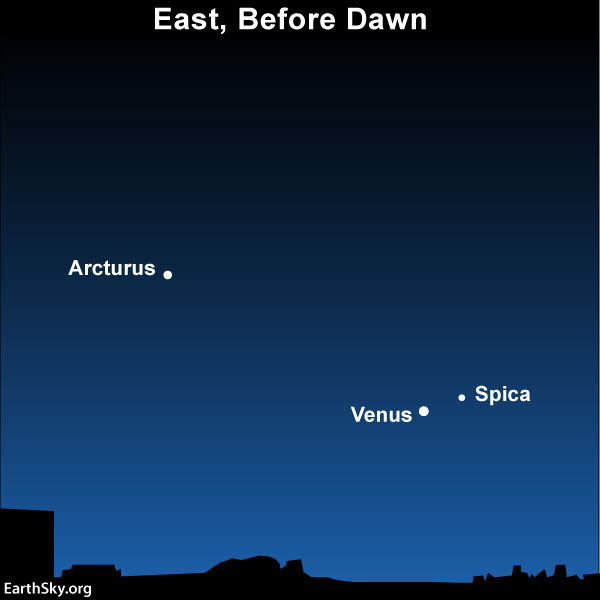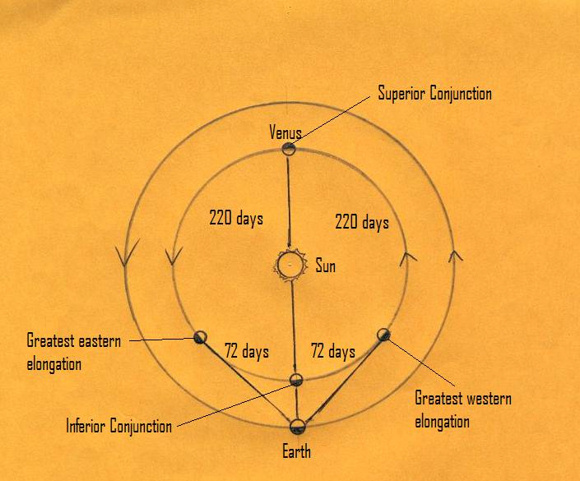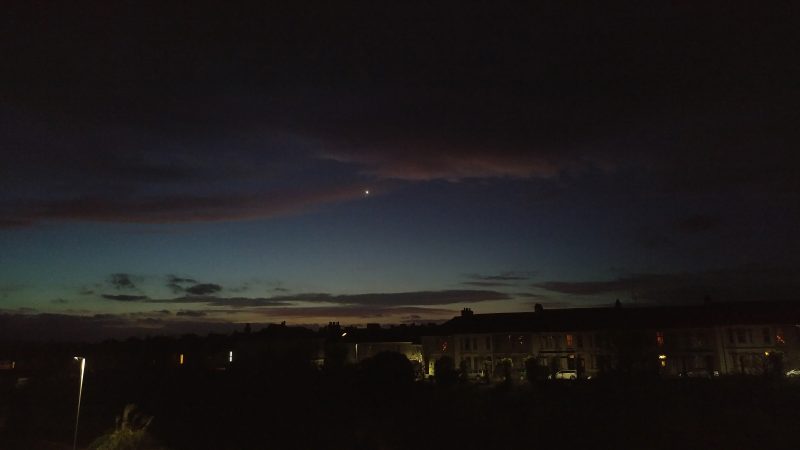In late November and early December, 2018, the dazzling planet Venus will be shining at greatest brilliancy in the morning sky. Venus is always the third-brightest celestial object, after the sun and moon. Even so, Venus’ brightness now – at maximum – is some 2 1/2 times greater than Venus at minimum brightness.
Because Venus is an inferior planet – orbiting the sun inside Earth’s obit – this world shows the whole range of phases, much like Earth’s moon. Throughout the rest of 2018, you’ll need a telescope to view Venus as a waxing crescent world.
And, perhaps, it’ll surprise you that Venus shines most brightly when its disk is only about 25 percent illuminated by sunshine, as viewed from Earth.
The 2019 lunar calendars are here! Order yours before they’re gone. Makes a great gift.


Venus’ disk will become 100 percent illuminated in sunshine some 8 1/2 months from now (August 14, 2019). But – at that time – Venus will be nearly five times farther from Earth than it is right now. Hence, the illuminated portion of Venus’ disk will actually cover less square area of sky – and Venus will be less bright – when seen as fully illuminated next August.
Thus you might see that greater brilliancy for Venus is a trade-off between the apparent size of the planet’s disk, and the extent to which we see the disk illuminated by sunlight. That’s why astronomers tend not to speak in terms of Venus’ greatest brilliancy. Instead, with more precision, they speak of the greatest illuminated extent of Venus.

Like many sky phenomena, the waxing and waning of Venus is cyclical and predictable. When Venus is in the evening sky, due to pass between the Earth and sun – as it did last on October 26, 2018 – the distance between Earth and Venus is decreasing. At the same time, we’re seeing less and less of the planet’s day side. Thus, before Venus enters the morning sky, Venus’ phase is shrinking, but its disk size is enlarging.
The converse is also true. After Venus has passed between us and the sun – and is fleeing ahead of us in orbit, as now – we find it in the morning sky, with the distance between our two worlds increasing. Now, Venus is in a waxing phase; we’re seeing more of its day side each day. But its disk size is diminishing because it’s rushing ahead of us in orbit.

Venus passed between us and the sun on October 26, 2018. So this world was closer to Earth over the last month or so, yet its phase was exceedingly thin. Throughout the most of November, the illuminated portion of Venus (the sliver we could see of its day side) covered less square area of sky than it does at present. On December 1 or 2, 2018 (depending upon your time zone), Venus will reach its greatest illuminated extent – that moment of trade-off when the illuminated portion of Venus’ disk (the part we see) will cover the maximum area in Earth’s sky.
At or near greatest illuminated extent, Venus always shines most brightly in Earth’s sky.
That is the case for Venus, now.

So Venus last passed between the Earth and sun on October 26, 2018. Some 72 days after this inferior conjunction, Venus will reach its greatest elongation (that is, its maximum angular separation from the sun) on January 6, 2019. At that point, Venus’ disk will be approximately 50 percent illuminated in sunshine.
At Venus’ last greatest eastern elongation on August 17, 2018, Venus reigned over the evening sky; and at the coming greatest western elongation – on January 6, 2019 – Venus will reign in the morning sky. In ancient times, the Greeks actually called Venus Hesperus when she dominated the evening sky and Phosphorus when she loomed over the morning sky. Did they know these two entities were really a single world? Some say yes, and some say no.
Midway between greatest eastern (evening) elongation and inferior conjunction, Venus’ disk is about 25 percent illuminated in sunshine and this is when Venus shines brightest in the evening sky.
Then, midway between inferior conjunction and greatest western (morning) elongation, Venus’ disk is again 25 percent illuminated in sunshine and this is when Venus beams most mightily in the morning sky.

Bottom line: In late November and early December, Venus enjoys her glory days – her greatest brilliancy – in the morning sky. Look east before sunup! Greatest illuminated extent for Venus – when this world shows us the maximum amount of its bright, reflective surface – will come on December 1 or 2, 2018, depending upon your time zone.












